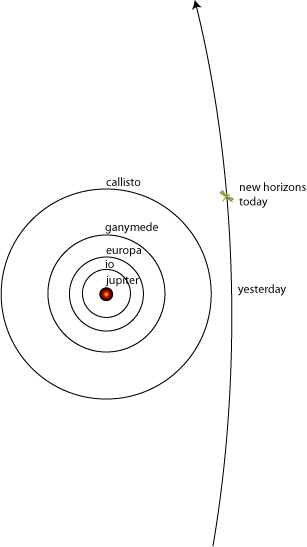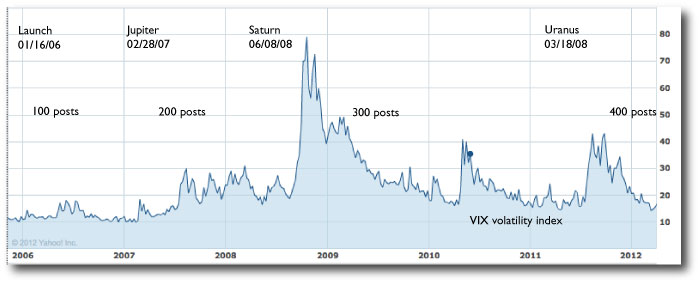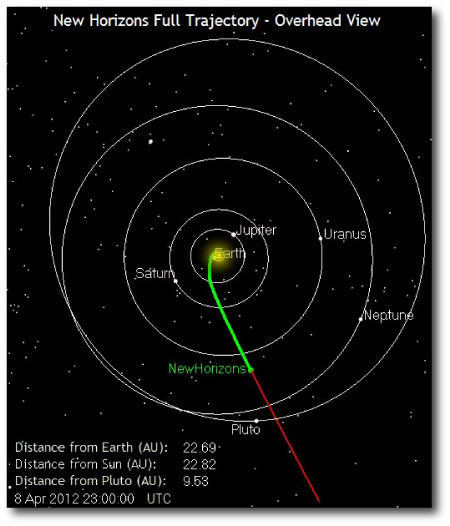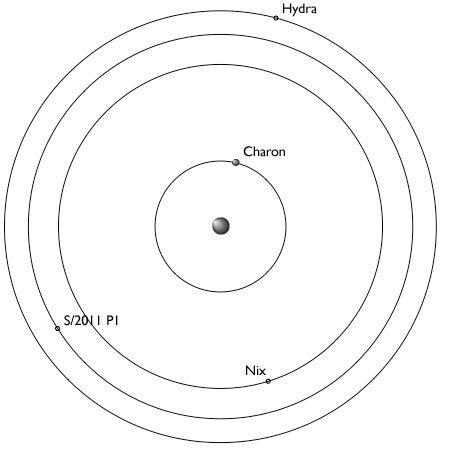Time slips by. It’s now been more than six years since launch and more than five years since the New Horizons probe got its gravitational assist from Jupiter. I looked back through the oklo.org archives and found a post covering the event.

One day, one hour, and nine minutes ago, the New Horizons spacecraft sailed flawlessly through its closest approach to Jupiter. A day later, Jupiter still looms large in New Horizon’s field of view, with an angular size more than five times greater than the size of the full moon in our sky.
That was on March 1st, 2007, a day after the 500 point drop in the DJIA that signaled the first shudder of unease portending the global financial crisis.
Oklo.org and New Horizons have both been gradually slowing down over the past six years, with New Horizons passing the orbit of a planet at roughly the cadence of 100 additional oklo posts. New Horizons is currently 9 AU from Pluto, and will arrive in the system in July 2015.
I discovered from reading the wikipedia page that a third circumbinary satellite was recently found in orbit around Pluto and Charon.
The three small moons in the Plutonian system are surprisingly reminiscent of what we might expect a typical circumbinary extrasolar planetary system to look like: orbital periods measured in weeks, masses of order a part in ten thousand of the central binary, low eccentricities, and orbits that are close to, but not in mean-motion resonance. During the next few years, as the Kepler data continues to roll in, and as the eclipsing binary systems in Kepler’s field of view are carefully scrutinized, we’ll find out whether such properties are indeed the norm.





New Horizons shall no doubt answer many questions (and provide many new ones) for this fascinating representative of the Edgeworth-Kuiper Belt. It is almost as if the successive discoveries are a taster of things to come…
If you are going to blog about Pluto, this question is far game: do you think the IAU was wrong to deplanetize Pluto in 2006?
I mean, fair game, of course….
I prefer a historically stringent view which limits the planets to the five classical wanderers of the heavens. I would advocate, furthermore, that astronomers and the media refer to any “planet” detected or confirmed via the Doppler velocity method as a “single-lined spectroscopic binary”.
Over the following decades, as more and more exotic exoplanets come into the fray the definition of a planet shall no doubt be re-visited. By that time no doubt a whole plethora of objects shall have been brought into the fray, ranging from the size of Pluto to the size of Jupiter (boundary conditions – for purposes of argument). With diameters that are incrementally graded from one boundary object to the other. It should be a fascinating debate at the IAU!
Perhaps a point of reflection here is that human beings always wish to compartmentalize things… Everything is fine for so long until nature goes and puts a spanner in the works!